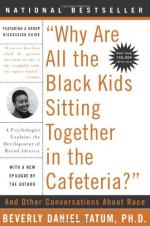
|
| Name: _________________________ | Period: ___________________ |
This quiz consists of 5 multiple choice and 5 short answer questions through Part II, Understanding Blackness in a White Context, Chapter 3, The Early Years.
Multiple Choice Questions
1. What groups benefit from systems of racism (and other isms), according to the author?
(a) Political groups.
(b) Fringe groups.
(c) Radical groups.
(d) Dominant groups.
2. In her courses on the psychology of race, Tatum often finds that parents like to brag about what quality of their children?
(a) Intelligence.
(b) Kindness.
(c) Colorblindness.
(d) Deafness.
3. Beverly Daniel Tatum earned her PhD in clinical psychology from which university?
(a) The CUNY Graduate Center.
(b) The University of Michigan.
(c) Boston College.
(d) Hartford Seminary.
4. What refers to the state of being withdrawn or isolated from the objective world, as through indifference or disaffection?
(a) Alienation.
(b) Tacit.
(c) Prejudice.
(d) Disadvantaged.
5. When was 'Why Are All the Black Kids Sitting Together in the Cafeteria?': A Psychologist Explains the Development of Racial Identity published?
(a) 1989.
(b) 2003.
(c) 1997.
(d) 1992.
Short Answer Questions
1. Erik Erikson is most famous for having coined what phrase?
2. What refers to an affective state of consciousness in which joy, sorrow, fear, hate, or the like, is experienced, as distinguished from cognitive and volitional states of consciousness?
3. In Part I, A Definition of Terms, Chapter 2, The Complexity of Identity, Tatum writes that she sometimes runs an experiment in classes with young students to write down as many responses to an "I am ____" question as they can in what period of time?
4. When was Erik Erikson's book Childhood and Society published?
5. What refers to a distressing emotion aroused by impending danger, evil, pain, etc., whether the threat is real or imagined?
|
This section contains 248 words (approx. 1 page at 300 words per page) |

|




